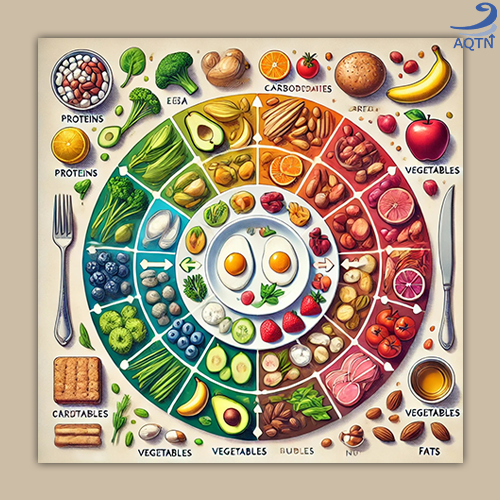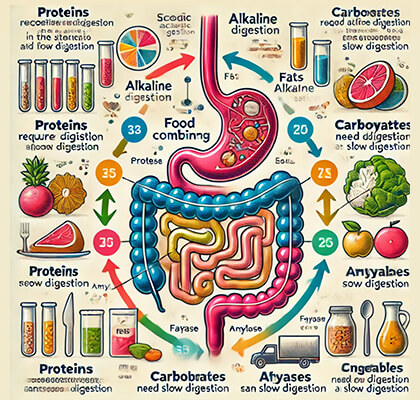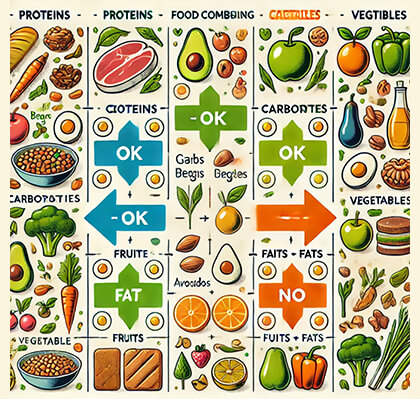
The Science Behind Food Combining: A Nutritionist’s Perspective
Food combining, or “combinaisons alimentaires,” is an approach to eating that suggests certain foods are better digested when consumed together, while others may cause digestive issues if paired incorrectly. This idea has gained popularity, especially within naturopathic circles, but from a nutritionist’s perspective, it’s important to separate myth from fact. While proper digestion is essential for health, the human digestive system is designed to handle mixed meals, and there’s limited scientific evidence to support many food combining rules.
In this article, we will explore food combining from a nutritionist’s point of view, examine the claims behind it, and provide a more evidence-based approach to how macronutrients interact during digestion.
What Is Food Combining?
Food combining is based on the belief that different macronutrients (carbohydrates, proteins, and fats) require different digestive environments. According to this theory:
- Proteins (such as meat, fish, eggs, and legumes) need an acidic environment for digestion.
- Carbohydrates (such as grains, bread, pasta) are digested in an alkaline environment.
- Fats (like oils and butter) slow digestion and should be paired carefully.
The idea is that consuming certain combinations together, like proteins and carbohydrates, leads to poor digestion, fermentation in the gut, and bloating. Proponents recommend separating these macronutrients to optimize digestion and improve overall health. But how valid are these claims from a scientific and nutritional standpoint?
From a nutritional perspective, the body is designed to handle a variety of foods at the same time. In fact, meals that contain a mix of macronutrients are typical in human diets. Here’s a breakdown of how the digestive system efficiently handles mixed meals:
- Enzyme Versatility : The digestive system releases a cocktail of enzymes in response to food intake. Different macronutrients—proteins, fats, and carbohydrates—are broken down in different parts of the digestive system, and the body is well-equipped to process them simultaneously. These processes occur in parallel, allowing the body to digest mixed meals without difficulty.
- Carbohydrates begin digestion in the mouth with enzymes like amylase.
- Proteins are broken down in the stomach by acidic gastric juices.
- Fats are emulsified by bile in the small intestine.
- Optimal Nutrient Absorption : Eating a balanced meal that includes proteins, fats, and carbohydrates is actually beneficial for nutrient absorption. For instance:
- Fat-soluble vitamins (A, D, E, K) require fats for proper absorption, so pairing fats with vegetables or lean proteins can enhance their bioavailability.
- Protein intake along with carbohydrates can help stabilize blood sugar levels and promote satiety.
- Meal Composition and Satiety : From a nutritionist’s perspective, balanced meals are key to maintaining energy levels and managing weight. Meals containing all three macronutrients tend to be more satisfying, preventing overeating and helping to regulate appetite.

Debunking Common Food Combining Myths
While food combining theory suggests certain pairings are “bad” for digestion, these claims aren’t backed by scientific evidence. Here are some common myths and the science behind them:
- Myth: Proteins and Carbohydrates Shouldn’t Be Combined
The idea that proteins and carbohydrates need vastly different environments for digestion is inaccurate. The stomach can handle multiple tasks simultaneously, producing the necessary enzymes to break down both proteins and carbohydrates at the same time. Research shows that meals with mixed macronutrients don’t hinder digestion in healthy individuals. - Myth: Fruits Should Always Be Eaten Alone
Another popular food combining rule suggests that fruit, especially sweet fruit, should be eaten on its own to avoid fermentation in the gut. While it’s true that fruit is digested relatively quickly, there’s no evidence that combining fruit with other foods leads to fermentation or digestive problems in most people. In fact, pairing fruit with a protein or fat can help slow down sugar absorption and prevent blood sugar spikes. - Myth: Fats and Proteins Slow Down Digestion
While it’s true that fats slow the emptying of the stomach, this is not necessarily a negative effect. In fact, it promotes satiety and helps control hunger levels. Slower digestion does not mean poor digestion; it simply allows for better nutrient absorption and helps keep you feeling full for longer.
Rather than focusing on rigid food combining rules, nutritionists emphasize the importance of balanced, nutrient-dense meals that include all macronutrients. Here’s why:
- Macronutrients Work Together
Each macronutrient serves a specific role in the body. Carbohydrates provide quick energy, proteins are essential for muscle repair and growth, and fats help with hormone production and vitamin absorption. Combining these macronutrients ensures that your body has all the tools it needs to function optimally. - Balanced Blood Sugar Levels
When you eat carbohydrates alone, they can cause a rapid spike in blood sugar followed by a crash. Including protein and fat in your meal slows down the absorption of carbohydrates, leading to more stable blood sugar levels. This is crucial for sustained energy and preventing overeating. - Improved Nutrient Absorption
Certain nutrients, like fat-soluble vitamins (A, D, E, and K), require fat for absorption. Similarly, iron from plant-based foods is better absorbed when eaten with vitamin C-rich foods. By mixing food groups, you can optimize your body’s ability to absorb key vitamins and minerals.

A Scientific Approach to Food Combining: Practical Tips
While strict food combining rules are unnecessary, there are some evidence-based strategies that can improve digestion and overall health:
- Eat Fiber-Rich Foods : Including non-starchy vegetables and whole grains in your meals can improve digestion by supporting gut health and promoting regular bowel movements.
- Avoid Overeating : Eating large meals can overwhelm the digestive system, leading to discomfort. Smaller, balanced meals are easier to digest.
- Chew Your Food Thoroughly : Proper chewing aids digestion by breaking down food into smaller particles, allowing digestive enzymes to work more efficiently.
- Stay Hydrated : Water helps in digestion by assisting the breakdown of food and the absorption of nutrients. Drinking water between meals rather than during meals can help avoid diluting digestive enzymes.
Summary Table of Balanced Macronutrient Combinations
| Macronutrient/Category | Common Combinations | Benefits |
| Proteins (meat, eggs, legumes) |
Carbohydrates (rice, pasta), Fats (avocado, olive oil) | Stabilizes blood sugar, supports muscle repair |
| Carbohydrates (bread, grains, fruits) |
Proteins, Fats (nuts, seeds) | Slows digestion, provides sustained energy |
| Fats (oils, butter, avocado) |
Proteins, Vegetables | Improves satiety, enhances vitamin absorption |
| Fruits | Proteins, Fats (yogurt, nuts) | Slows sugar absorption, balances energy |
| Non-Starchy Vegetables | Combine with any macronutrient | Adds fiber, supports digestion |
Conclusion
From a nutritionist’s perspective, the concept of food combining is more myth than science. The human digestive system is designed to handle mixed meals with ease, and separating macronutrients is unnecessary for most people. Instead of following rigid rules, focus on creating balanced, nutrient-rich meals that provide a variety of proteins, carbohydrates, and fats. This approach not only optimizes digestion but also promotes better health and sustained energy throughout the day.
By emphasizing balance and variety, you can enjoy the benefits of all macronutrients without restricting how you combine them.
